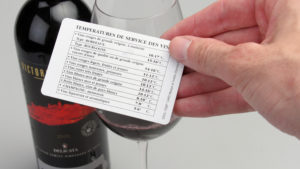The Big Wine Chill
I catch myself often fretting over being served wines too warm for my liking, particularly in summer when dining open-air.
Now don’t go thinking I’m an absolute wine purist, though. I readily admit that charts which give a degree by degree, wine by wine list of precise serving temperatures running to dozens of wines can make the prospect of opening any bottle seem like treading a minefield.
However, wine’s serving temperature deserves more attention than unthoughtfully following the old-fashioned and oversimplified diktat that white wine be served cooler than red which is poured chambré or room warm. Getting it wrong turns zest into flab, velvet into ink.

Wine Temperature Chart
Let’s be clear: the phrase ‘room temperature’ was coined in the days of draughty, uninsulated houses before central heating was the norm in temperate climates. It didn’t spring to mind in a country where al fresco dining means fanning your way through a three-course meal in the sweltering summer heat. 13 to 18 °C is what is meant; that’s cellar cool.
Fashion and taste at both national and personal levels will probably disagree about the ideal pouring temperature of wine. But, honestly, red wines are far better served slightly chilled than routinely so warm as to be almost soupy, a bad habit untrained waiting staff don’t seem to be able to shake despite my insistence as a punter.
Taking into account the climate, it makes sense to slightly chill even a light or low-tannin red wine. A fruity red drunk on a clammy winter’s day in London or Paris would taste rounded and comforting at the higher end of the scale. The same wine drunk on a scorching-hot terrace in Malta would taste boiled this warm, but restorative when slightly cool to the touch.
Whilst I’m fully aware that drinking over-chilled wine can cheat the drinker of much flavour that the bottle has to give, one ought to deliberately seek to err on the cooler side of the quicksilver – serving wine warm is always an irretrievable mistake, and not just for red wine.
Once served, the natural progression of the temperature of a wine is, after all, upwards by about 1 °C every three minutes until it reaches the ambient temperature. Exposed to the hot air it will warm up quickly to reach unpleasant, lukewarm temperatures.
There’s certainly something to say in favour of overzealously cooling white and rosé wines if they’re going to be served in the sweltering outdoors. Served colder rather than warm, white and pink wines will be more refreshing to drink, have a better structure if they’re low in acidity, taste less cloying when sweet and lose their fizz less rapidly if they’re sparkling.
Serving a wine too cold has got to be far better, especially in summer. Even if patrons prefer their wine less chilled, all that’s needed is a few minutes of patience. Soon enough the over-chilled wine will climb up the thermometer hitting its sweet spot at which the wine gives its true flavour. And, one can, of course, always speed up the process by warming up the glass in the cup of one’s hand.
Wine stewards should remember as well that rigorous attention to temperature of the wine in bottle is not enough. Wine glasses must be of the appropriate temperature, too. Keeping precious bottles in showy, wood-clad refrigerators and tabling them in flashy ice buckets or Vinicools is futile if the chilled wine is poured in glasses still warm from the dishwasher or which have been sat baking under the midday sun. Hot stemware can make red wine smell unpleasant and vinegary through no fault of the winemaker.
When entertaining at home, my regimen on serving temperatures is simple. From the rack, I gently stick a bottle of red upright in the fridge door for 60 minutes. White wines including sweet ones and rosés go for just as long in the deep freeze to chill down to 8 to 11 °C where sparkling wines are kept for 2 hours before serving them at about 6 to 8 °C.
If it’s a better wine I will go on decanting it regardless of its colour. This pussyfooting gives frigid complex, wood-aged whites just enough time to warm up to my guests and me, whereas a little more patience is needed for reds to continue to open up in our glasses. And, if I suspect my eager invitees think I’ve got my reds too cold, I’ll simply break the ice by joking that I adhere to the cooler, French way of serving.
This article by Georges Meekers appeared first in the Times of Malta, 10th June 2016


